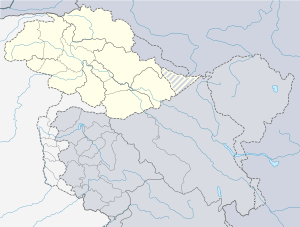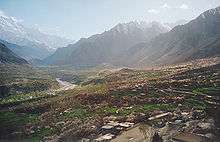Ganish
Ganish (also Ganesh) is a village in Pakistan. It is the oldest and first settlement on the ancient Silk Road in the Hunza Valley, and is the site of various ancient watch towers, traditional mosques, religious centers, and a reservoir. It is located 90 km and 2.5 hours traveling time from Gilgit. Ganish means gold in Brushaski.[1]
Ganish | |
|---|---|
 Ganish Location in Hunza Pakistan  Ganish Ganish (Pakistan) | |
| Coordinates: 36.315°N 74.668°E | |
| Country | Pakistan |
| Autonomous state | Gilgit-Baltistan |
| Division | Gilgit Division |
| District | Hunza District |
| Elevation | 2,240 m (7,500 ft) |
| Time zone | UTC+5 (PST) |
| • Summer (DST) | UTC+6 (PDT) |

UNESCO awards
Ganish is home to 4 mosques that are 300-to-400 years old.[2] They were awarded UNESCO Heritage Award for Culture Heritage Conservation in 2002.[3][4]
The Ali Gohar House in Ganish, is located next to one of the iconic shikari watchtowers of the town. A few watch towers have survived the harsh weather and collapse due to sliding towards South East. The fortified settlement has 40 feet tamurkux watch tower which was used in the past for the surveillance of surroundings especially at night's. The settlement used to be at the high risk of attacks and looting because of its location along the ancient Silk Road. The 400-year-old house was awarded the UNESCO Asia-Pacific Awards for Cultural Heritage Conservation in 2009.[5]
Administration
The sub-villages of Ganish include Garelth, Chaboikushal, Shukunoshal, Gamun Ganish, Buldas and Chillganish.
Chaboikushal is a sub-village of Ganish.[1] This small village is located right in the heart of Hunza Valley. There are about 25 houses or families. Chaboikushal was derived from Chaboi, the grandfather of Sheril. According to old men in the village, Chaboi was migrated from Iran, where he had two sons: Helo and Melo. Melo remained and raised in Chaboikushal and Helo migrated to Nagar valley. The one who resided in this village was one of the bravest persons of his times, hardworking and the closest to King of Hunza.
Chillganish is a sub village of Ganish. There are 25 families living here. Chillganish is one of the most ancient villages of Ganish which has rich history. The residents of Chillganish belong to well-known tribe Chillganishkuz. The word chill means water and Ganiskuz means residents of Ganish. Sheikh Ali was a prominent cleric in Chillganish and Haji Muhammad Bilal (late) was main leader from the area who was also the first Haji (pilgrim of Kab'a) from Hunza. Jamia tul Zehra is the main institution for education in Chillganish.Qadimi Imambargarh is rich in its artwork carried out by the artisans of the ancient times. The wood carving work of the Imambargah is known for its beauty.
Garelth is also a sub-village of Ganish with a population of about 135 families. FG Boys Middle School, Aga Khan Diamond School are the main educational institutions. Former Member District Council Gilgit Baltistan Jan Alam, Former Chairman Village Council Darvesh, and Muhammad Ali Barcha have been leading politically. Currently Ghulam Mustafa Barcha, grandson of Major Ghulam Murtaza is Chairman of Garelth Hunza.
Subedar Major Fida Ali, one of the main leaders of independence movement of Gilgit-Baltistan, belongs to this village. Fida Ali played a key role in the independence of Gilgit-Baltistan. He was a key figure who launched the freedom movement against the Dogra dynasty in Gilgit. Major Ghulam Murtaza (Sitara-e-Jurat), a key person in the revolution of independence movement of Gilgit-Baltistan, also belongs to this village. He made major gains by leading troops into India. His graveyard is located next to KKH at Garelth.
See also
- Karimabad
- Altit
- Hunza Princely State
References
- Hyder, Sajjad (2010). "Ganish - Oldest Village Of Hunza". Ganish. Archived from the original on 2011-08-17. Retrieved 22 December 2019.
- Salopek, Paul (January 29, 2018). "Relict Walls of the Ancient Silk Road". National Geographic Society.
The ornately carved door of a 400-year-old mosque in Ganish, Pakistan. Before Islam, the region was Buddhist, and before that Zoroastrian—a testament to the tides of ideas moving along the Silk Road.
- "Unesco heritage distinction award for Ganish-Hunza". DAWN. April 8, 2003. Retrieved 22 December 2019.
- "2002 Award of Distinction: Yarikutz, Rupikutz, Kuyokutz, Mamorukutz Mosques". UNESCO Office in Bangkok. 2002. Retrieved 22 December 2019.
- Leelakitichok, S (1 September 2009). "Sangiin Dalai Monastery in Mongolia wins the Award of Excellence in the 2009 UNESCO Asia-Pacific Heritage Awards" (PDF) (Press release). Bangkok: UNESCO Bangkok. Retrieved 22 December 2019.
The second Award of Distinction, the Ali Gohar Housein Hunza, Pakistan, has transformed the former house of the village lord into a center showcasing the living heritage of the historic settlement of Ganish.